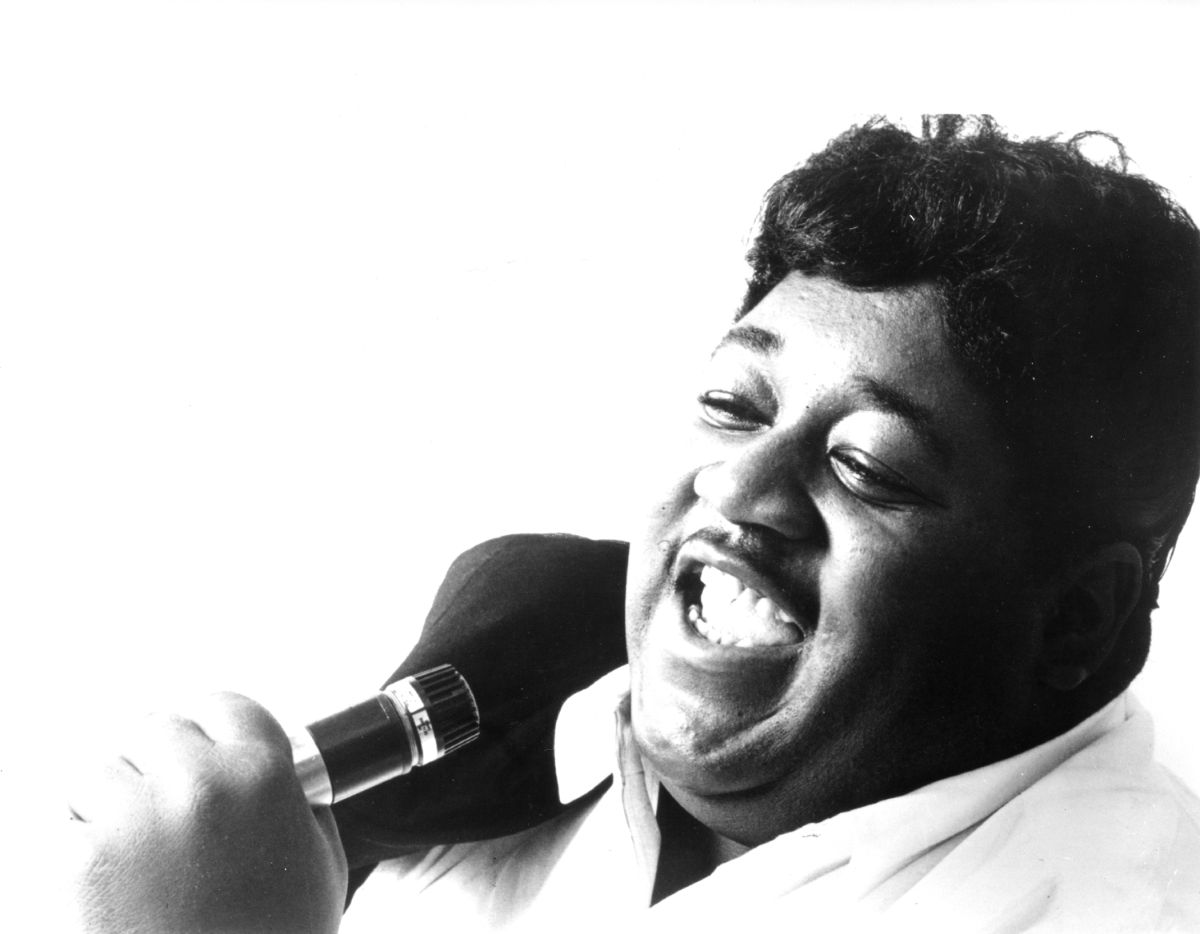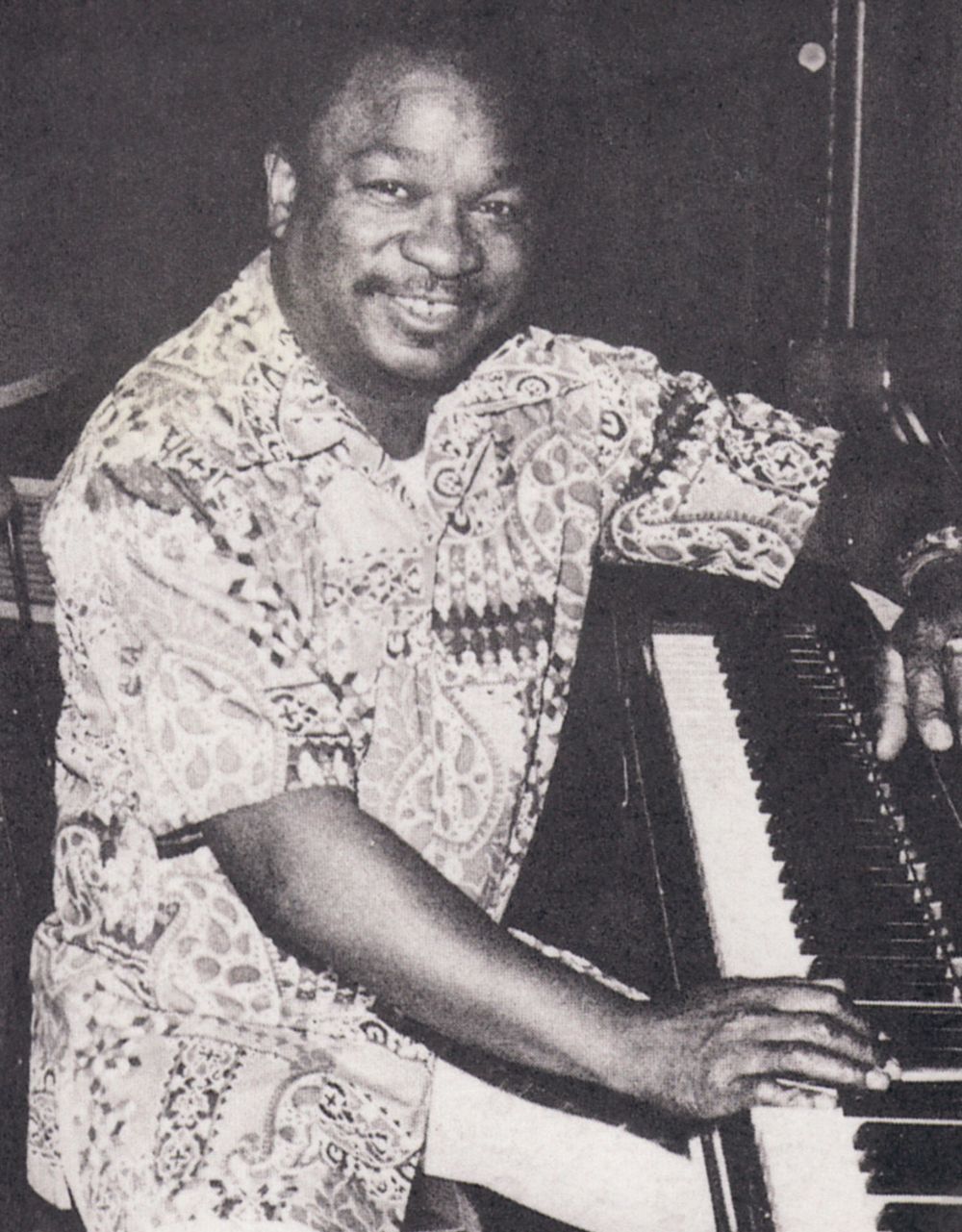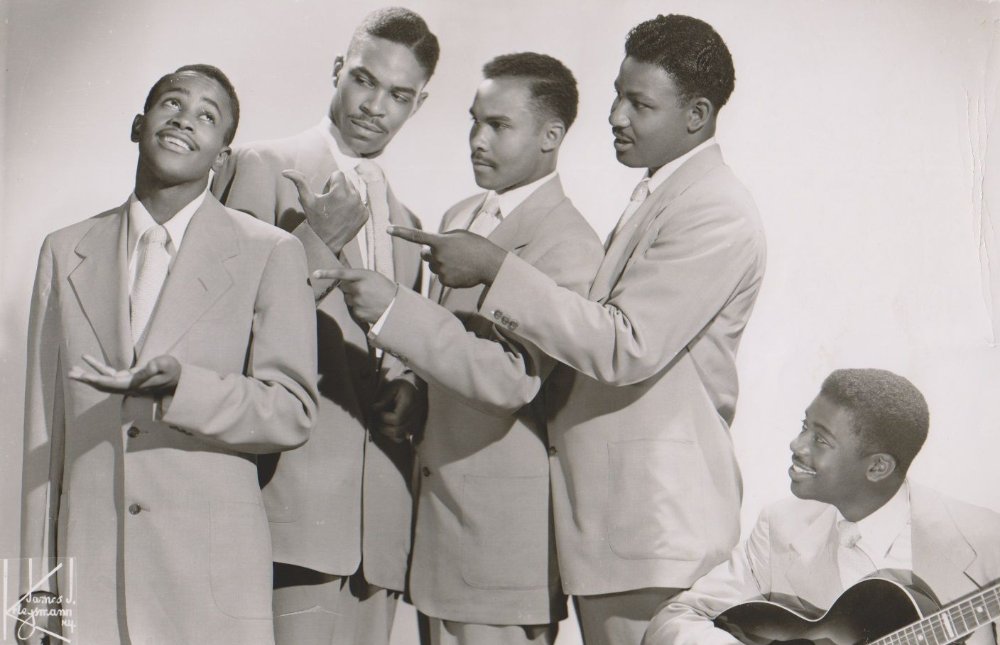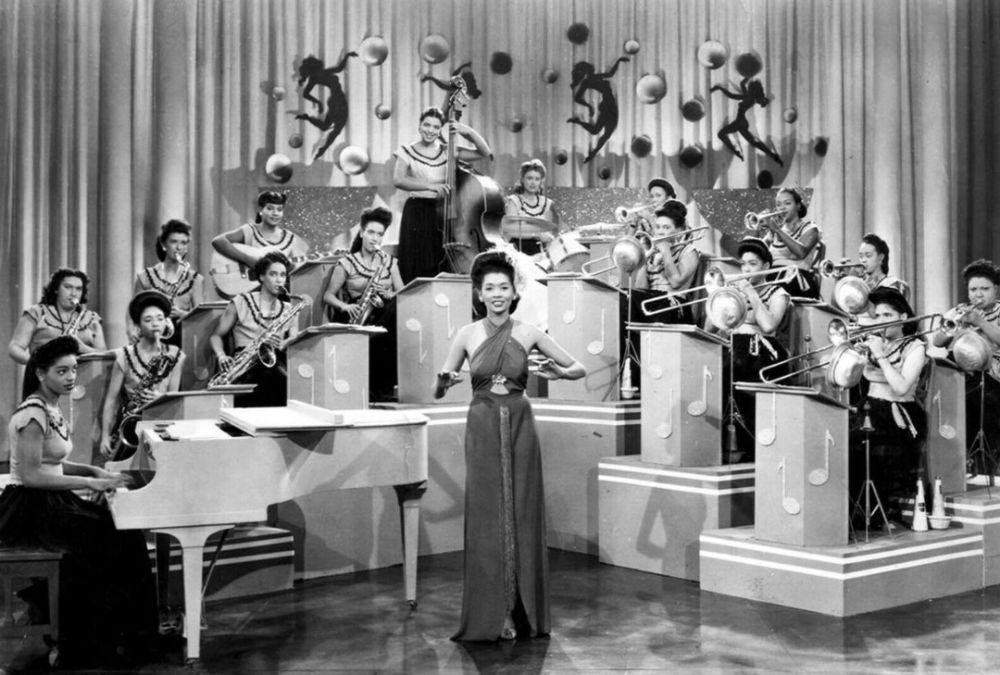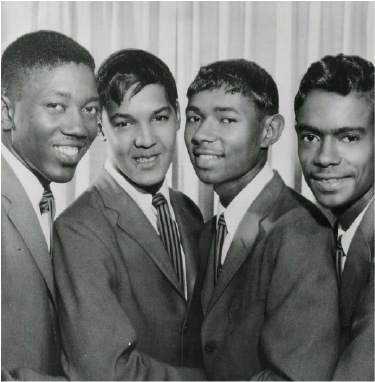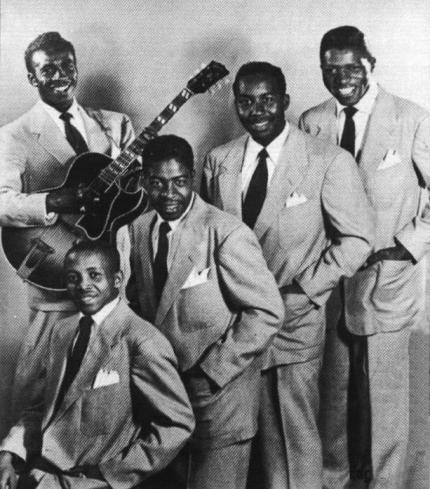The tough-voiced blues shouter known as Angel Face, whose sound is comparable to that of Ruth Brown and Lavern Baker, was born in New Orleans, Louisiana, in 1930. Her given name was Elsie Mae Jones. (Kenley appears to be a married name.) After singing with famous New Orleans trumpet player and bandleader, Papa Celestin, in her hometown, Angel Face eventually landed in DC, working with Thomas “TNT” Tribble and then extensively with Frank “Dual Trumpet” Motley and His Motley Crew.
Baby Dee (Delores Spriggs)
Baby Dee was born Delores Spriggs on August 1, 1927, in Washington, DC. She grew up in a family of entertainers – her mother Ernestine Boggerson Spriggs was a performer and her father Daniel Spriggs was a comedian. Baby Dee attended Randall Junior High in Southwest D.C., which is one of the schools that a number of artists featured in our exhibit attended.
Billy Stewart
William Larry Stewart II was born and raised in Washington, D.C. Billy Stewart was a talent far beyond most R&B singers of the 1960’s. He had a signature sound which no one could imitate. His rolling tongue, scatting, and vibrato gave a uniqueness to his songs.
Bo Diddley
Bo Diddley is a recognized icon, innovator, and legend of rock ‘n’ roll and rhythm and blues music. He was born Otha Ellas Bates on December 30, 1928, in McComb, Mississippi, but lived in Washington, D.C. from about 1957 to 1966. He had a recording studio in his home on Rhode Island Avenue in N.E., and artists such as Billy Stewart, The Marquees (with Marvin Gaye) and The Jewels practiced and/or recorded there.
Bobby Parker
Bobby Parker – a longtime resident of Washington, DC, area – was a guitarist and well-respected blues and R&B artist. He began performing in his teens in the 1950’s when he lived in Los Angeles, California.
Calvin “Hound Dog” Ruffin
Calvin “Hound Dog” Ruffin, Sr., born in 1924, was a native Washingtonian. His family was very music-oriented. His brother, Isaiah ‘Bubba’ Ruffin, sang with the Chantelairs in the early 1950’s. Also, the next generation produced son, Calvin, Jr., a vocalist and drummer; niece Grace Ruffin, who sang with The 4 Jewels; nephew Paul Ruffin, who sang with Mask Man and the Agents; and other nephews, The Stewart brothers – Billy, Johnny, and Frankie – as well as The Bruton Sisters, a gospel trio. All were accomplished vocalists and instrumentalists.
The Cap-Tans
The Cap-Tans were formed in 1948 when DC Records owner, Lillian Claiborne, encouraged Harmon Bethea to break away from The Progressive Four and join an existing group called The Buddies, which consisted of Alfred Slaughter, Lester Fountain, Floyd Bennett, and Sherman Buckner.
The Clovers
The Clovers formed at Armstrong Vocational High School in 1946, and went on to become the most successful vocal group from Washington in the 1950’s bar none.
The Coolbreezers
The Coolbreezers of Washington, DC, started out singing gospel but eventually switched to doo-wop. Their members were Joseph ‘Joe’ Ruth (lead), Richard Steward (first tenor), Sonny Williams (bass), Earl J. Williams, Bob Armstrong, and William Primrose. The vocal group was managed by Bea Williams (listed as Bea Tibbitts on record), who was the sister of members Sonny and Earl Williams.
The Cruisers
The Cruisers formed among friends during the 1950’s in Northeast, Washington, D.C. The members were Gene Williams, McKinley Anthony, Randy Hamilton, and Paul Long, originally from Philadelphia. Long was the group’s founder and leader; Gene Williams handled the lead vocals; and McKinley Anthony sang second tenor.
The Dippers
The Dippers formed in the early 1950’s, although the precise year is not currently known. Sometime in 1955, the Dippers made their first recordings, “It Must be Christmas” and “Look What I Found.” By 1956, the group established themselves citywide by placing multiple times as finalists in WUST Radio’s talent show at the Howard Theater hosted by DJ Jackson Lowe. Their first recording was the outcome of the group winning such a contest. The record was sponsored by and released on the Flayr record label, owned by renowned news photographer, Theodore Gaffney.
Don Covay
Don Covay was an accomplished vocalist and songwriter whose career encompassed gospel, doo wop, R&B, and Soul. Throughout his career, he drew on these song forms to compose and perform an impressive number of hits for himself and others.
The Four Bars
The Four Bars, originally called The Four Bars of Rhythm, were formed by Armstrong High School student, Eddie Daye, who sang bass. In addition to Daye, the group consisted of Melvin Butler (second tenor), Alphonso Feemster (lead), and Francis Henry (baritone). The Four Bars was revived after Daye’s discharge from the Army in 1953.
Frank “Dual Trumpet” Motley
Frank Motley was a talented musician and entertainer who, for a few short years in the early 1950’s, forged a new instrumental sound in rhythm and blues based out of Washington. Perhaps best known for his ability to play two trumpets at once, Frank was a well-trained musician who also had a knack for entertaining a crowd. While none of his many recordings hit the national sales charts, several of his titles made under the auspices of Mrs. Lillian Claiborne and her DC Records operation have achieved cult status. “Honkin’ At Midnight” (1955) and “Space Age” (1958) are two fine examples.
Greg Gaskins
A Washington, D.C. native, Greg Gaskins was raised in NW near the U St. area and its lively commercial and entertainment businesses. He began playing professionally when he was 16 years old. He joined the noted D.C. band, The El Corols Band, in the late 1950’s, frequently performing as the house band at Carr’s Beach in Annapolis, MD. With the El Corols, he backed national artists including Patti LaBelle and the Bluebelles, Dionne Warwick, and Martha Reeves & the Vandellas. He later performed in Billy Stewart’s band at the Howard Theater and other venues. While working with Stewart at the Howard Theater, Greg had a fortunate encounter with The Manhattans; they hired him as their guitarist and he spent three years on tour with them.
International Sweethearts of Rhythm
The International Sweethearts of Rhythm was the traveling big band from The Piney Woods Country Life School of Mississippi. Formed in 1937, they spent most of the year on the road on extended fundraising trips, much in the spirit of The Fisk Jubilee Quartet of the previous century.
The Jewels
Formed in 1958 while attending Roosevelt High School in Washington, DC, the group was first known as the Impalas, then the Renaults. The Four Jewels consisted of Sandra Bears, Grace Ruffin, Margie Clarke, and Carrie Mingo.
In 1962, under the direction of DC producer Bob Lee, The Four Jewels recorded the single “Loaded With Goodies” on the Start Label. During this time, Bob Lee changed the name of The Four Jewels to The Jewels.
Jimi Smooth
Jimi Smooth, born James Smoot, is an “Entertainer’s Entertainer.” A native Washingtonian and product of DC Public Schools, Jimi has been in show business and performing with a live band since he was 15 years old. He began singing on the street corner singing Doo-Wop in the 50’s. He was influenced by such legends as The Moonglows, The Drifters, and The Spaniels led by “Pookie” Hudson.
Jimmy McPhail
Jimmy McPhail, a commanding presence among Washington’s talented vocalists, is better known among jazz fans than R&B and rock’n’roll aficionados. Yet, over his multi-decade career he performed in many musical settings.
Lloyd Price
Lloyd Price – who’s also known by his nickname, “Mr. Personality” – hardly needs an introduction. He is the recipient of the 1994 Pioneer Award from the Rhythm & Blues Foundation, a 1998 inductee in the Rock & Roll Hall of Fame, and a 2019 inductee in the National Rhythm & Blues Hall of Fame. He was born in Kenner, Louisiana, on March 9, 1933, and raised in a family of 11 children. His parents owned a restaurant where he worked as a youth and he also sang in a Gospel Choir. Price had his first No. 1 hit at the age of 16 with the song, “Lawdy Miss Clawdy.”
The Marquees
The Marquees vocal group formed mainly from members who attended DC’s Cardozo High School. Chester Simmons developed the Marquees out of the Rainbows with members Reese Palmer, James Nolan, and Marvin Gay, who later changed his last name to Gaye.
The Memories
The Memories, originally named The Bob-O-Links, started in the Anacostia neighborhood of Southeast, Washington, D.C. The group was established by Kramer Junior High School classmates Ronnie Lutz and Jimmy Durst in 1957. At Anacostia High School, the group was rounded out with the addition of Gene Fitzgerald, “Boots” Dove, and Lou Martin.
Phil Flowers
Phil Flowers – who came to be known as “The Black Elvis” – was a versatile artist who had a career in entertainment for nearly 50 years. Born in Longwood, NC, in 1934, he joined the Air Force in the early 1950’s and was stationed in Washington, D.C. Flowers, who performed regularly at DC area venues, appeared on the Dick Clark Show in the 1960’s. In 1968, DC Mayor Walter Washington requested that Flowers and his group sing around town to calm the city after Dr. Martin Luther King, Jr.’s assassination.
The Rainbows
The Rainbows are perhaps the most storied of Washington’s R&B vocal groups. They descended from a group called The Serenaders who made demo recordings for Mrs. Lillian Claiborne of DC Records around 1952.
Rick Henderson
A consummate professional, Henderson established the music publishing company, Federal City Publishers, to market his compositions and arrangements for big-bands. He also performed a number of dates in groups led by Clark Terry and Dizzy Gillespie.
The Starlighters
The Starlighters was a vocal group that formed in high school, as was the case with many D.C. vocal groups. They formed around 1955 and the original members were Van McCoy (lead vocals), Fred Smith, Paul Comedy, Bernard Whisonant, and Charles Smith. Later, Bernard Whisonant and Charles Smith left the group and Smith was replaced by Van’s brother Norman McCoy. The group, initially working as The Starlings, recorded a demo of the songs “Slim Jim” and “So Close to Me” at Edgewood Studios in Washington, D.C. In their early days, Vi Burnside – who was a saxophonist and former member of the International Sweethearts of Rhythm as well as Freddie Smith’s cousin – served as their manager.
The Four Dots
The Four Dots formed in 1947, consisting of students from Randall Junior High School who sang in the glee club. Even though D.C. Public Schools were segregated at that time, their experience in glee club was beneficial to their development as vocalists. Their sound was reminiscent of The Ink Spots, who rose to fame in the 1930’s and are widely renowned as the predecessors of doo-wop. In many ways, The Four Dots reflected the cultural and local music scene in post WWII Washington, D.C.
The Heartbreakers
The Heartbreakers formed in Southwest, Washington, DC, around 1948, consisting of brothers James ‘Jay Boy’ Ross and William Ross along with Lawrence Tate (guitar) and Fred ‘Nugie’ Holmes. The group added singer/songwriter Bobby Evans as their fifth member after he wrote a song in hopes of joining them called “Heartbreaker”. (Evans would go on to write all the songs that the group recorded.)
The Progressive Four
The Progressive Four was one of the finest vocal quartets to come out of Washington in the late 1940s. Their reputation endured long after their radio broadcasts faded into the background and their 78rpm records became obsolete and hard to find. Group members included lead tenors Harmon Bethea and Lindsay Wilson as well as Hartwell Mouton, Wilburt Griffin, and Oliver Armstead, along with integral guitarist Thomas Singleterry. The group was especially adept at switching harmony parts amongst the members, a technique which caused their listeners to focus more intently on their performances.
Thomas “TNT” Tribble
For more than 60 years, TNT Tribble – a drummer, singer and bandleader – was a leading figure in Washington, DC’s live music and recording scene. TNT was born in Georgia in 1921 but his family moved to DC via Farrell, Pennsylvania, in the early 1930’s. He attended Phelps Vocational High School and served in the U.S. Army during World War II, including a deployment to the Philippines. His nickname – “TNT” – came from an Army platoon sergeant who could not pronounce ‘Thomas Edward Tribble.’
The Truetones
The Truetones were a D.C. vocal group whose history is a bit mysterious due to limited sources of information and the fact that a number of groups eventually used some form of that name. Regarding the group we’re highlighting on this page, one established fact is that Ronald Henderson was the group leader and lead vocalist. Like many young men of that time, Henderson – who was born in 1936 in Southeast D.C. – was inspired by popular vocals groups of the time such as The Mills Brothers and The Ink Spots, whom he was listening to on the radio.
The Velons
The Velons are an incredibly talented vocal group with nearly 60 years of performing and recording under their belt. They continue to dazzle audiences with their blend of harmony, which recaptures the sounds and spirit of a time when love songs echoed in the hearts of the young and young at heart. Their polished vocals and use of “blow” harmony have been compared to legendary vocal groups such as The Moonglows and The Flamingos.


